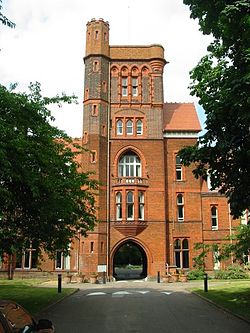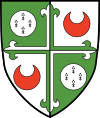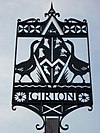Girton
| Girton | |
| Cambridgeshire | |
|---|---|
 Girton College | |
| Location | |
| Grid reference: | TL422615 |
| Location: | 52°13’59"N, 0°4’59"E |
| Data | |
| Population: | 3,752 (2001) |
| Post town: | Cambridge |
| Postcode: | CB3 |
| Dialling code: | 01223 |
| Local Government | |
| Website: | http://www.girton-cambs.org.uk/ |
Girton is a sizable village in Cambridgeshire. It lies about two miles to the northwest of the City of Cambridge, and is the home of Girton College, part of the University of Cambridge. The college was a pioneer in women's education, and was established here after moving there from a previous site in Hertfordshire in 1872.
Girton has about 1,600 households, and 4,500 people according to estimates.
The village is named as Grittune in around 1060 and Grittune in the Domesday Book. The village's name is derived from the Old English greot tun meaning "farmstead or village on gravelly ground", as the village was formed on a gravel ridge.[1]
History
Girton has a long history, and has been home to a poor settlement for thousands of years. The parish lies on the Via Devana, the Roman road, and a cemetery with at least 225 burials between the second century AD and the early Anglo Saxon period was found near to Girton College in 1880. In addition, traces of agriculture from the late Bronze Age and Roman period were found to the north of the village in 1975. A selection of Saxon items are stored in the collection of Girton College.[2]
In 1872, the College for Women at Benslow House was moved here from Hitchin and renamed Girton College, which opened on its new site in October 1873. The philosophy behind establishing the college here rather than in Cambridge itself was a practical one: it had to be close enough for lecturers to go back and forth from the city to the college, but far enough that ardent young men would not beset the lady undergraduates with the their solicitations.
The initial buildings had cost £12,000, and consisted of a single block which comprised the east half of Old Wing. At the time, thirteen students were admitted. In 1876, Old Wing was completed, and Taylor's Knob, the college laboratory and half of Hospital Wing built. In 1884, Hospital Wing was completed, and Orchard Wing, Stanley Library and the Old Kitchens added. At that time, Girton had 80 students. By 1902, Tower Wing, Chapel Wing and Woodlands Wing as well as the Chapel and the Hall were finished, which allowed the college to accommodate 180 students.
It was only in 1924 that the College’s charter was drafted and granted by the King to "the Mistress and Governors of Girton College". On 27 April 1948, women were admitted to full membership of the University of Cambridge, and Girton College received the status of a college of the university.
Church
The parish church has been dedicated to St Andrew since at least 1240. Part of the west tower contains stones that were probably part of an earlier 11th century church on the site, and there are parts of 13th century construction still in evidence, but the present building was largely rebuilt in the 15th and 16th centuries.[2] The church was owned by Ramsey Abbey from the 12th century until the Dissolution of the Monasteries.
Ellen Wordsworth Darwin née Crofts, the second wife of Sir Francis Darwin is buried in the churchyard of St. Michael's Church.
A Baptist church was built in the village in 1860.[2]
Village sign
The current village sign, situated on the corner of Redgate Road and Cambridge Road was erected in 1985 after a fund-raising campaign.
Designed by Denis Cheason and made by Barry Sharman, the design is formed from a number of separate images. The top part of design is based on a Roman belt discovered in a burial ground near Girton College. The centre is derived from the family coat of arms of Anne-Maria Cotton, who endowed the first Girton village school, together with geese, kept at Washpit, that provided quills for use in the University of Cambridge. The flowers near the village's name are corn marigolds which were once common in the village, and at the base is the cross of Saint Andrew to whom the parish church is dedicated.[3]
Village life
Girton is a student village and supports three public houses; the Old Crown opened in around 1840, The George (formerly the George and Dragon) was opened by a blacksmith in the 1850s, and The Traveller's Rest which is a modern addition on Huntingdon Road on the outskirts of Cambridge. The village's first pub, the White Horse was opened in around 1760 but closed in the late 20th century.[2]
Outside links
| ("Wikimedia Commons" has material about Girton) |
References
- ↑ A. D. Mills, A Dictionary of British Place-Names (2003)
- ↑ 2.0 2.1 2.2 2.3 A History of the County of Cambridge and the Isle of Ely: Volume 9: Chesterton, Northstowe, and Papworth Hundreds
- ↑ "Girton village website". http://www.girton-cambs.org.uk.


